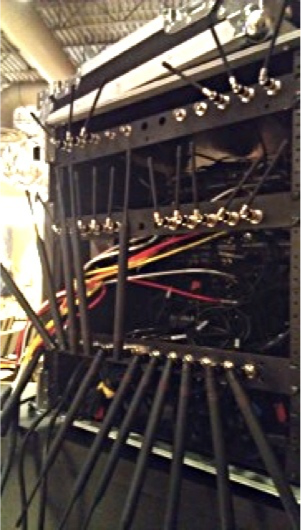5G wireless, rural mobile broadband, and broadcast television repacking have shrunk available bandwidth and increased interference for many wireless microphone users. It’s not unusual for us to get a call from someone who “never had any issues before” to be suddenly plagued by interference that they can’t figure out.
Often, we’re tasked with helping figure out whether it’s an issue with a new TV station, an older wireless system, really cheap wireless systems, a system that a casual user brought from home, antenna placement, battery voltage, channel/frequency selection or a combination of factors.
We have special software and other tools that can help us get to the bottom of an issue, but we’d like to share some technical info and best practices to help you stay one step ahead.
Have you ever seen a rack that looks like this?

But what exactly makes this a problem? And what are some other things you can do to increase your chances at perfect wireless performance?
Antenna Placement
At the most basic level, in order to achieve best diversity performance, the receiver antennas should be placed at precise 90° angles from each other. As you can see in the photo above, that is nearly impossible if you have multiple receivers mounted in a rack.
Aside from antenna interference, having all of your antennas mounted inside any rack creates lots of other possible sources for interference from equipment power supplies, digital processors and spinning drives. And if that rack is also metal, you’re headed for a bad day before you start.
Additionally, make sure that you have a clear line of sight from transmitter to receiver antennas. Placing your wireless antennas at knee height, in a closet, or behind a wall can be a problem, especially when the crowd arrives.
Increased Noise Floor
Your wireless system antennas receive and re-broadcast at the same time, so you can end up with neighboring antennas creating interference for the other systems depending on frequency spacing. Similarly, your wireless receivers leak a bit of signal back out into your antenna where it shows up as an increase in noise floor which makes it harder for transmitters and receivers to communicate clearly and reliably. Think about how hard it can be for you to hear the person next to you in a noisy room. Same thing in the wireless environment.
All of that said, none of these factors by themselves are necessarily a deal-breaker. Wireless systems can and often do work in unconventional scenarios without a problem, but starting with better practices with respect to antenna placement, antenna management and channel selection will take you a long way toward optimal performance, and from having a critical issue at a time when you don’t need one.
One of the best solutions available to minimize antenna clutter and improve performance is to deploy an antenna distribution system with a single antenna for all systems.
With products from RF Venue, we can help you operate up to 81 systems together, to the extent that your systems are capable of that. Most of our clients utilize between one and twenty systems together, and choosing the Distro4 or Distro9 HDR, along with a Diversity Fin antenna will take you a long way toward getting the job done well.
Let us know how we can help you troubleshoot what you have and/or find the right antenna distribution system for your use.
